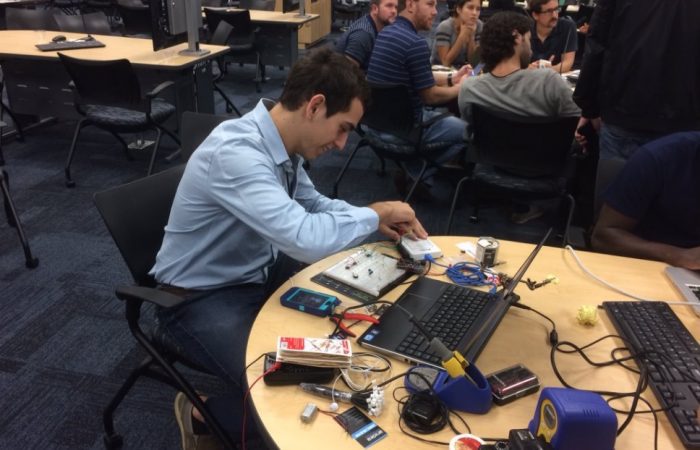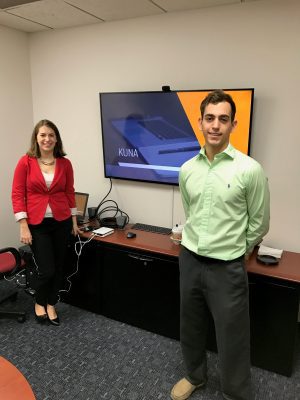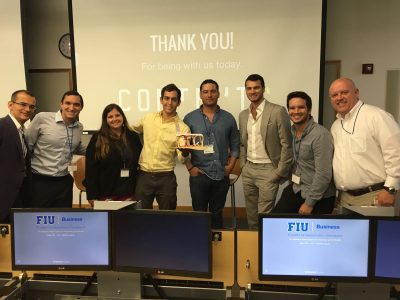
Alarm systems and smoke detectors are some of the tools used today to keep homes safe. But as more smart homes come online, an electrical engineering student has designed a project that jumps into action during emergencies, and has caught the eye of IBM.
For Adrian Mederos, it all started last summer when he was one of the winners of the Innovation Challenge sponsored in part by StartUP FIU. His idea was an innovative, sheltered bus stop that offered air conditioning and Wi-Fi. IBM, which was one of the event’s sponsors, took notice, and approached him.

Meanwhile, Valeria Siegrist, an undergraduate studying entrepreneurship already had a relationship with IBM after meeting executives at a hackathon. Siegrist is involved in the tech industry through her involvement with StartUP FIU where she works as a student director in the area of innovation and economic development. She had also met Mederos at Social Tech Live, a social media and technology conference hosted at FIU, which is where Mederos had participated in the Innovation Challenge.
IBM officially connected the two students and presented them with a challenge – the IBM Centralite IoT Device Project. They were given a box of hardware and devices created by Centralite, a manufacturer of lighting control and automation systems. In the box were water, motion, door and relay sensors, along with a hub. The hub works like a brain, communicating with the sensors and relaying the information to the internet, a system which has come to be known as the Internet of Things (IoT). Perhaps you’ve heard of a smart home, which refers to homes equipped with devices that can be controlled remotely.
“IBM sees great value in exposing academia to cutting edge technology,” said Daniel E. Arzonico, IBM public sector, Internet of Things/Continuous Engineering Solutions. “IoT is a key focus area for our company, as we work side by side with clients to help them tap into IoT data for business transformation. Allowing students to experience IBM solutions is a win for all involved. It’s a very good investment in the future.”

Mederos and Siegrist set out to interconnect social media with the sensors they were given while applying cognitive services from IBM Watson, a new class of systems that combine artificial intelligence (AI) and analytical software that learn at scale, reason with purpose, and interact with humans naturally. The duo used Watson to scan social media and detect users’ status of emotion – are they scared, angry, sad? That information would then be used to understand if a crisis is occurring.
The idea came from recent California wildfires. The team found that people were sharing information on social media during the crisis, and that data could then be used to provide insight and connect with hardware in the home. For example, if a fire was closing in, and a home was interconnected (smart home), the information would be relayed to the hub, which then would activate sensors to power off appliances or even turn on the sprinklers.
“Valeria and I know that social media is being used for crises and emergencies. If we mine the data, we can better respond during an emergency, and that’s the solution we were trying to propose,” said Mederos. “The way technology is evolving, we need to react fast so that we don’t have major damages in times of emergencies. The more interconnected we are, the better we can react. It’s only logical to increase our ability to react to these situations.”
IBM is meeting with the students and local government officials to highlight their project, and show its potential for Miami-Dade County.
“This project is a great demonstration of IBM engaging with academia, providing premium exposure of our innovative solutions to help develop a well-rounded student with solid understanding of technology, and who can contribute to our society once they are out in the world,” Arzonico said.
In Miami-Dade, the technology could be used for emergencies such as flooding. If there was a riot, the fear could be picked up on social media, and the system could respond by increasing the security in the home, and for example, lock doors automatically.
Siegrist is excited about the opportunity, and hands-on experience.
“We’re bringing a solution that solves a real problem. We want to provide the talent, and this is how students learn.”
Arzonico agrees, and believes in the potential of this dynamic duo.
“I must say Adrian and Valeria are two very amazing students. They have very unique skill sets as students for leadership, technology development, business development, marketing, and social media,” he said. “They have been able to meld the technology and business side of academia together to successfully deploy an IoT demonstration platform. This has been an investment in the future and a model has been developed here for future success with FIU and industry.”

Mederos also just got selected to represent FIU at MuniMod, a statewide competition that invites 10 teams, each representing their university, to develop technological solutions for cities. He will present the IoT device. The contest winner gets $10,000, and the Florida League of Cities, which organizes the event, then connects the winning student team with the municipalities that may be able to implement their technology as a way to modernize municipal government across the state.





